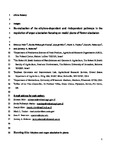Re-evaluation of the ethylene-dependent and -independent pathways in the regulation of floral and organ abscission
| dc.contributor.author | Meir, S | en |
| dc.contributor.author | Philosoph-Hadas, S | en |
| dc.contributor.author | Riov, J | en |
| dc.contributor.author | Tucker, ML | en |
| dc.contributor.author | Patterson, SE | en |
| dc.contributor.author | Roberts, JA | en |
| dc.date.accessioned | 2019-10-23T09:46:06Z | |
| dc.date.issued | 2019-02-06 | en |
| dc.identifier.issn | 0022-0957 | en |
| dc.identifier.uri | http://hdl.handle.net/10026.1/15052 | |
| dc.description.abstract |
Abscission is a developmental process with important implications for agricultural practices. Ethylene has long been considered as a key regulator of the abscission process. The existence of an ethylene-independent abscission pathway, controlled by the complex of INFLORESCENCE DEFICIENT IN ABSCISSION (IDA) peptide and the HAESA (HAE) and HAESA-like2 (HSL2) kinases, has been proposed, based mainly on observations that organ abscission in ethylene-insensitive mutants was delayed but not inhibited. A recent review on plant organ abscission signaling highlighted the IDA-HAE-HSL2 components as the regulators of organ abscission, while the role of auxin and ethylene in this process was hardly addressed. After a careful analysis of the relevant abscission literature, we propose that the IDA-HAE-HSL2 pathway is essential for the final stages of organ abscission, while ethylene plays a major role in its initiation and progression. We discuss the view that the IDA-HAE-HSL2 pathway is ethylene independent, and present recent evidence showing that ethylene activates the IDA-HAE-HSL2 complex. We conclude that the ability of an organ to abscise is tightly linked to cell turgidity in the abscission zone, and suggest that lack of cell turgidity might contribute to the failure of floral organ abscission in the ida mutants. | |
| dc.format.extent | 1461 - 1467 | en |
| dc.language | en | en |
| dc.language.iso | en | en |
| dc.publisher | Oxford University Press (OUP) | en |
| dc.title | Re-evaluation of the ethylene-dependent and -independent pathways in the regulation of floral and organ abscission | en |
| dc.type | Journal Article | |
| plymouth.issue | 5 | en |
| plymouth.volume | 70 | en |
| plymouth.journal | Journal of Experimental Botany | en |
| dc.identifier.doi | 10.1093/jxb/erz038 | en |
| plymouth.organisational-group | /Plymouth | |
| plymouth.organisational-group | /Plymouth/REF 2021 Researchers by UoA | |
| plymouth.organisational-group | /Plymouth/REF 2021 Researchers by UoA/UoA06 Agriculture, Veterinary and Food Science | |
| plymouth.organisational-group | /Plymouth/Users by role | |
| plymouth.organisational-group | /Plymouth/Users by role/Academics | |
| plymouth.organisational-group | /Plymouth/Users by role/Researchers in ResearchFish submission | |
| dcterms.dateAccepted | 2019-01-15 | en |
| dc.rights.embargodate | 2020-02-05 | en |
| dc.identifier.eissn | 1460-2431 | en |
| dc.rights.embargoperiod | Not known | en |
| rioxxterms.versionofrecord | 10.1093/jxb/erz038 | en |
| rioxxterms.licenseref.uri | http://www.rioxx.net/licenses/all-rights-reserved | en |
| rioxxterms.licenseref.startdate | 2019-02-06 | en |
| rioxxterms.type | Journal Article/Review | en |


